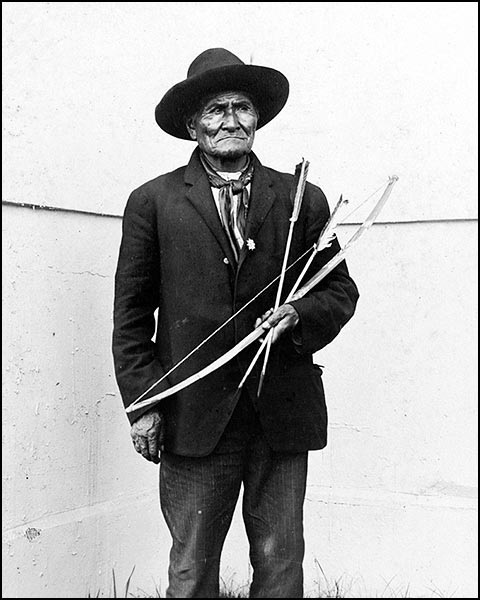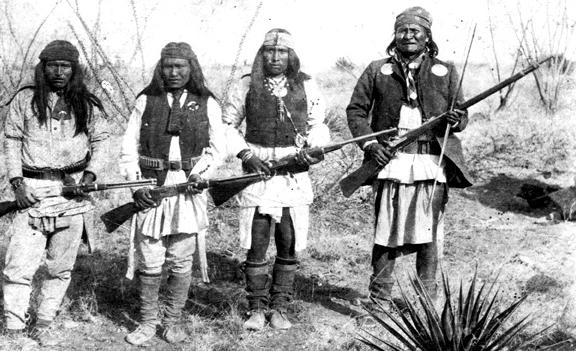Archives
28
Jun 10
Rites of Passage
Brian Huberman and Jerry Eagan were guests on the Voices of the West radio show last year. Eagan, Apache-country expert and historian, has been a guest on the show several times and has, in recent years, helped BH access the landscape he is so fascinated to explore in one of his latest film projects: Geronimo Country.
Listen to the podcast to hear them paint a vivid picture of the physical landscape of this American wilderness, past and present, and explain some of the historical and political events that make this such a fascinating and dangerous place in America today.
Brian also discusses a bit about his personal background, his interest in the Western film genre and why this quest has him so determined to visit Skeleton Canyon, the site where Geronimo surrendered for a final time.
Other highlights: tactics Apaches used to throw Calvary members off their trail, Brian's favorite Western film score composers and how Jerry, a Vietnam Vet living in Oregon, came to be an expert guide in the wilderness of New Mexico.
02
May 10
Southern Arizona’s war zone evokes Geronimo’s struggle
Rob Krentz, the victim in this border incident was a neighbor to the Kimball family who gave me access to film in Skeleton Canyon. (See film clip from Geronimo Country on our Works in Progress page.)
The drug cartel madness infecting Mexico makes any visit to the Canyon de los Embudos even less likely than before. Located only 25 miles south-east from Douglas, AZ, this important site in frontier history remains inaccessible. Ironically, the situation probably is not disimilar from when Geronimo's "last hold out band" prowled the mountains & rocky desert of the region. It is a waiting game.

 May 10-17 BH productions return to New Mexico to continue filming Geronimo's Country. Topics to be covered, if all goes well, include visits to the San Carlos Agency AZ., that Geronimo escaped from in 1885. This was to be his final break-out/raid & concluded with his surrender at Skeleton Canyon, Sept. 1886. Also, we hope to go to Geronimo's birthplace located north of the Mogollon range & not easy to access.
Jerry Eagan, our guide, fell & broke his ankle while hiking alone since our last visit. Filming will begin with a visit to where the fall took place & include the story of how he dragged himself through the rocks and back to his vehicle.
Death & damage await all who enter this tough landscape. Nothing has changed much since the Spanish began raping the ground for copper in the 18th century. Water remains the key to survival & must be shared with rattlesnakes & mountain lions. Even the people encountered on the trail must be viewed with suspicion. Each of us in this primordial setting must ask ourselves the simple question: are we predators, or are we prey?
May 10-17 BH productions return to New Mexico to continue filming Geronimo's Country. Topics to be covered, if all goes well, include visits to the San Carlos Agency AZ., that Geronimo escaped from in 1885. This was to be his final break-out/raid & concluded with his surrender at Skeleton Canyon, Sept. 1886. Also, we hope to go to Geronimo's birthplace located north of the Mogollon range & not easy to access.
Jerry Eagan, our guide, fell & broke his ankle while hiking alone since our last visit. Filming will begin with a visit to where the fall took place & include the story of how he dragged himself through the rocks and back to his vehicle.
Death & damage await all who enter this tough landscape. Nothing has changed much since the Spanish began raping the ground for copper in the 18th century. Water remains the key to survival & must be shared with rattlesnakes & mountain lions. Even the people encountered on the trail must be viewed with suspicion. Each of us in this primordial setting must ask ourselves the simple question: are we predators, or are we prey?

 May 10-17 BH productions return to New Mexico to continue filming Geronimo's Country. Topics to be covered, if all goes well, include visits to the San Carlos Agency AZ., that Geronimo escaped from in 1885. This was to be his final break-out/raid & concluded with his surrender at Skeleton Canyon, Sept. 1886. Also, we hope to go to Geronimo's birthplace located north of the Mogollon range & not easy to access.
Jerry Eagan, our guide, fell & broke his ankle while hiking alone since our last visit. Filming will begin with a visit to where the fall took place & include the story of how he dragged himself through the rocks and back to his vehicle.
Death & damage await all who enter this tough landscape. Nothing has changed much since the Spanish began raping the ground for copper in the 18th century. Water remains the key to survival & must be shared with rattlesnakes & mountain lions. Even the people encountered on the trail must be viewed with suspicion. Each of us in this primordial setting must ask ourselves the simple question: are we predators, or are we prey?
May 10-17 BH productions return to New Mexico to continue filming Geronimo's Country. Topics to be covered, if all goes well, include visits to the San Carlos Agency AZ., that Geronimo escaped from in 1885. This was to be his final break-out/raid & concluded with his surrender at Skeleton Canyon, Sept. 1886. Also, we hope to go to Geronimo's birthplace located north of the Mogollon range & not easy to access.
Jerry Eagan, our guide, fell & broke his ankle while hiking alone since our last visit. Filming will begin with a visit to where the fall took place & include the story of how he dragged himself through the rocks and back to his vehicle.
Death & damage await all who enter this tough landscape. Nothing has changed much since the Spanish began raping the ground for copper in the 18th century. Water remains the key to survival & must be shared with rattlesnakes & mountain lions. Even the people encountered on the trail must be viewed with suspicion. Each of us in this primordial setting must ask ourselves the simple question: are we predators, or are we prey? 21
Nov 09
Geronimo Country & American Violence
Twenty miles south of Douglas, AZ in old Mexico is located the Canon de los Embudos (Canyon of Funnels) where Geronimo and General Crook discussed Apache surrender terms in 1886. There was no surrender at this point however, the event is important because of the photographs of Camillus Fly.

18
Nov 09
After Geronimo, Undefeated
St. Louis, MO is a dreary city, where I recently attended an arts conference at Washington University. Met some interesting people; but most important was the opportunity to see the park where the 1904 Louisiana Purchase Exposition was held.
 To help celebrate America's status as a civilized nation, several "primitive" peoples were represented at the fair, including that monument of savagery, the Chiricahua Apache medicine man and chief: Geronimo.
Geronimo was still a prisoner of war and was given special dispensation by President Teddy Roosevelt to attend the fair where he was to sell photographs of himself. A captive of the United States since 1886, Geronimo had become a successful capitalist and hoped to make a profit from his photo sales. Unhappy with the financial deal offered him by the exposition organizers, Geronimo refused to participate in the events. On this occasion, savagery revealed itself to be stronger than the forces of civilization.
The photograph below was taken of Geronimo during the exposition. His expression reflects his undefeated state of mind. The following year he rode in Teddy Roosevelt's inaugural parade in Washington D.C. and in 1909 he "crossed the river" for the last time.
To help celebrate America's status as a civilized nation, several "primitive" peoples were represented at the fair, including that monument of savagery, the Chiricahua Apache medicine man and chief: Geronimo.
Geronimo was still a prisoner of war and was given special dispensation by President Teddy Roosevelt to attend the fair where he was to sell photographs of himself. A captive of the United States since 1886, Geronimo had become a successful capitalist and hoped to make a profit from his photo sales. Unhappy with the financial deal offered him by the exposition organizers, Geronimo refused to participate in the events. On this occasion, savagery revealed itself to be stronger than the forces of civilization.
The photograph below was taken of Geronimo during the exposition. His expression reflects his undefeated state of mind. The following year he rode in Teddy Roosevelt's inaugural parade in Washington D.C. and in 1909 he "crossed the river" for the last time.


At the Louisiana Purchase Exposition in Saint Louis, Missouri, a view of the Natural History Fossil Exhibit with the model of a whale and skeletons of several dinosaurs | Smithsonian Intstitute

Geronimo with arrows
27
Jul 09
Film Diary 2
This week, Brian Huberman (BH) productions are off in Silver City, New Mexico to continue filming for the work-in-progress, Geronimo Country.
The crew will meet up with Jerry Eagan, explorer and Vietnam War veteran, who is responsible for guiding the filmmakers through all of the Geronimo-country they have seen so far.
This trip, Brian hopes to learn more about Eagan's past as a volunteer infantrymen in the Vietnam War. Clearly, his experience as a point man, moving through the jungle, on the lookout for "the enemy" has very interesting resonance with the less visible subjects of the film: the Apache Indians, like Geronimo, who once roamed this now fenced landscape freely.
Eagan maintains a website, Hiking Apacheria, which he uses to sell photographs from his treks in this historically signficant landscape.

